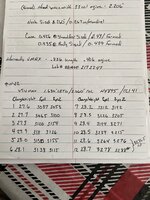SconnieRaised
FNG
If you're confident with a method that focuses velocity, I'd still recommend shooting 3 rounds (or at least 2) at each powder charge. With one shot at each 0.5 grain interval you're going to be wasting time and powder in chasing possible nodes that appear solely from random variability in the velocity of a given powder charge. You'll also probably be missing real nodes for the same reason. Taking the average velocity of the multiple shots at each charge is going to reduce the effect of random variability tremendously and provide much clearer data on the true behavior of a given charge. It'll also give you insight into the velocity spread for each powder charge. If you see two adjacent powder charges that generate similar average velocities and both have low velocity spread, then you're probably on to something.So they way that I learned to do my load development from an old wise man was to.
1 - Choose a bullet
2 - Choose a powder from published loads
3 - choose other components
4 - Load ladder @ 0.5 gr increments.
5 - Look for CONSISTENT fps gains in loads
6 - When 2 Loads flatten out next to each
other it’s a possibility you have a node.
7 - When such “node” appears, load in 0.2 gr
Increments between these 2 loads.
8 - After confirming “node” load 5 at charge
Weight and solidify “node”
9 - Load 10 and group.
This has worked flawlessly for me in the past but I had never ran into a lower fps at a higher charge like I did this time. That’s why I was thinking my rifle didn’t like this powder.
I’m going to sit down this evening and continue my ladder. Hopefully will go shoot it this weekend.
Sent from my iPhone using Tapatalk

